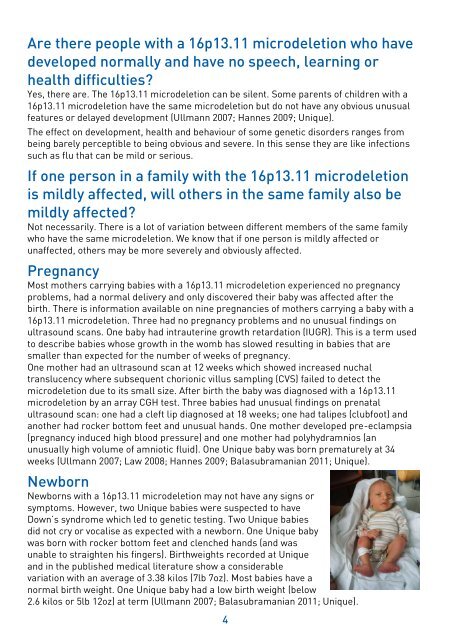16p13.11 microdeletions - Unique - The Rare Chromosome ...
16p13.11 microdeletions - Unique - The Rare Chromosome ...
16p13.11 microdeletions - Unique - The Rare Chromosome ...
You also want an ePaper? Increase the reach of your titles
YUMPU automatically turns print PDFs into web optimized ePapers that Google loves.
Are there people with a <strong>16p13.11</strong> microdeletion who have<br />
developed normally and have no speech, learning or<br />
health difficulties?<br />
Yes, there are. <strong>The</strong> <strong>16p13.11</strong> microdeletion can be silent. Some parents of children with a<br />
<strong>16p13.11</strong> microdeletion have the same microdeletion but do not have any obvious unusual<br />
features or delayed development (Ullmann 2007; Hannes 2009; <strong>Unique</strong>).<br />
<strong>The</strong> effect on development, health and behaviour of some genetic disorders ranges from<br />
being barely perceptible to being obvious and severe. In this sense they are like infections<br />
such as flu that can be mild or serious.<br />
If one person in a family with the <strong>16p13.11</strong> microdeletion<br />
is mildly affected, will others in the same family also be<br />
mildly affected?<br />
Not necessarily. <strong>The</strong>re is a lot of variation between different members of the same family<br />
who have the same microdeletion. We know that if one person is mildly affected or<br />
unaffected, others may be more severely and obviously affected.<br />
Pregnancy<br />
Most mothers carrying babies with a <strong>16p13.11</strong> microdeletion experienced no pregnancy<br />
problems, had a normal delivery and only discovered their baby was affected after the<br />
birth. <strong>The</strong>re is information available on nine pregnancies of mothers carrying a baby with a<br />
<strong>16p13.11</strong> microdeletion. Three had no pregnancy problems and no unusual findings on<br />
ultrasound scans. One baby had intrauterine growth retardation (IUGR). This is a term used<br />
to describe babies whose growth in the womb has slowed resulting in babies that are<br />
smaller than expected for the number of weeks of pregnancy.<br />
One mother had an ultrasound scan at 12 weeks which showed increased nuchal<br />
translucency where subsequent chorionic villus sampling (CVS) failed to detect the<br />
microdeletion due to its small size. After birth the baby was diagnosed with a <strong>16p13.11</strong><br />
microdeletion by an array CGH test. Three babies had unusual findings on prenatal<br />
ultrasound scan: one had a cleft lip diagnosed at 18 weeks; one had talipes (clubfoot) and<br />
another had rocker bottom feet and unusual hands. One mother developed pre-eclampsia<br />
(pregnancy induced high blood pressure) and one mother had polyhydramnios (an<br />
unusually high volume of amniotic fluid). One <strong>Unique</strong> baby was born prematurely at 34<br />
weeks (Ullmann 2007; Law 2008; Hannes 2009; Balasubramanian 2011; <strong>Unique</strong>).<br />
Newborn<br />
Newborns with a <strong>16p13.11</strong> microdeletion may not have any signs or<br />
symptoms. However, two <strong>Unique</strong> babies were suspected to have<br />
Down’s syndrome which led to genetic testing. Two <strong>Unique</strong> babies<br />
did not cry or vocalise as expected with a newborn. One <strong>Unique</strong> baby<br />
was born with rocker bottom feet and clenched hands (and was<br />
unable to straighten his fingers). Birthweights recorded at <strong>Unique</strong><br />
and in the published medical literature show a considerable<br />
variation with an average of 3.38 kilos (7lb 7oz). Most babies have a<br />
normal birth weight. One <strong>Unique</strong> baby had a low birth weight (below<br />
2.6 kilos or 5lb 12oz) at term (Ullmann 2007; Balasubramanian 2011; <strong>Unique</strong>).<br />
4

















